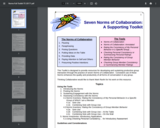
Micro video for finding and editing SNUDLE Investigations. For use by coaches, science specialists, and teachers.
- Subject:
- Applied Science
- Computer Science
- Material Type:
- Teaching/Learning Strategy
- Author:
- CAST
- OASIS
- SNUDLE
- Date Added:
- 01/11/2023

Micro video for finding and editing SNUDLE Investigations. For use by coaches, science specialists, and teachers.

From Thinking Collaborative, a toolkit of resources for starting, developing, and supporting effective, productive team collaboration.

Providing opportunities for all voices to be heard and all contributions to be recognized is an effective strategy for building science understanding, collaboration skills, and promotes successful group work.

Link to a simple graphic to support group discussion. This simple graphic points out three common ways children participate in discussions (repeating ideas, adding on to ideas, or proposing a new idea).

To build collaboration skills, ensure that each group member has an important role that contributes to the success of all.

To build collaboration and science expertise, try doing a jigsaw activity with students. The jigsaw strategy has been shown to improve social interactions in learning and support diversity.

Mastery and wise feedback can happen anytime. Use Mastery Oriented Feedback and Wise Feedback starters whenever students are trying something new or challenging.

Research has shown that peer feedback is especially helpful for the student giving the feedback. When peers are looking at other students work, they often report seeing the gaps in their own thinking, and then go back to their own work, revise, and improve.

Research shows that reflection and connecting with real-life situations are powerful and effective ways to build science sensemaking skills.

This quick strategy promotes communication skills and collaboration across science groups.

Every group has some people who participate a lot, and some who rarely speak. Yet, everyone has something to contribute AND something to get from hearing the voices of others. This strategy helps give everyone in the group space to speak and to listen.

Science is exciting and is always in action around us. Getting learners to realize that sometimes needs a dramatic or compelling story.Prime interest, connect science concepts with the real world, and build background knowledge with a hook. Try starting with a video, image or intriguing question to help students begin thinking about and making connections with a concept.

Tips for ensuring that all learners participate in data collection.